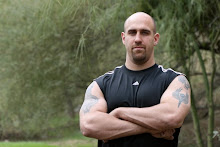One thing that I have definitely learned over the years is the old saying, "it is a small world" is very true. Recently a good friend and colleague sent me this link from nutrition expert, John Berardi's site:
http://www.precisionnutrition.com/members/showthread.php?t=13739
It first appears that John is very much in favor of using odd object training into one's program. I couldn't obviously couldn't agree more. In fact, it seems that John even enjoys some sandbag training (of course he could use a real sandbag!).

Then I am somewhat shocked by some of the following comments:
"So, the next logical question is this - "do you always do such weird workouts?"
The answer - absolutely not!
Every member of our group lifts weights - you know, squats, dead lifts, bench presses, and the rest of the usual suspects. For example, right now I'm actually following Eric Cressey's Maximum Strength Program.
In addition, every member of our group incorporates some form of more traditional conditioning exercise. For example, the girls mix it up with 45 min fasted walks on some mornings and interval sprints on other training mornings.
So, as you can see, this type of workout is IN ADDITION TO sound, periodized, mixed training. It's certainly not in place of it.
That's right, unlike many "industry wierdos" we don't get seduced by one type of training and vehemently extol its virtues until the end of time. To this end, we don't do ONLY "Sandbag Training," "Body Part Split Training," "Whole Body Training," "Functional Training," "Heavy Duty Training," "Cross-Fit," or any other style of training.
Instead, we figure out what's fun and what works...and then we use it. Novel idea, eh? And to this end, about 80% of our workouts are more traditional."
I have great respect for Mr. Berardi, but these comments strike me funny. No, it isn't because I sell sandbags, but because at my very core I believe these "weird" workouts can often enhance strength more than "traditional" workouts. In fact, the very implication of "traditional" is strange to me as the invention of the barbell is only a about 100 years old. Yet, physical training goes back thousands of years. What did we all do before the barbell and bench?!
I have a lot of anecdotal evidence as well. When I was training for my first strongman competition I didn't perform much deadlifting. Tire flipping and stones covered that pretty well. Within three weeks I put 35 pounds on my deadlift! Not only that, but I was much thicker and dense.
Yet, why do such professionals have such reservations? The truth of the matter is it comes down to a few factors.
1. They don't use these implements and tools in an organized fashion like they would most gym exercises. It seems when it comes to training with odd objects, using well thought out programming goes out the window. Instead it becomes a "play day" which is fine, but don't expect great results.
2. They don't go heavy enough. I am so sick and tired of seeing on television athletes flipping 200 pound tires. Guess what, you still need load!! No disrespect to Mr. Berardi, but our women that average 140 pounds often flip 400 pound tires. Does this mean you need to handle maximal loads to get a good result? Of course not, however, you need to utilize a load and use it in the same manner and respect you would give a barbell.
3. Be more creative in the programming. We get so stuck on weights that we forget there are numerous ways to measure progress.
A. Take a load and try to perform as many repetitions in 30 seconds, i.e. tire flip, log press, sandbag shouldering, etc.
B. Use a scale of perceived rate of exertion.
C. Perform ladders.
D. Utilize density training.
As you can see numerous methods exist and this is a short list. You can't possibly judge odd objects if you don't use them in a well thought manner. If I applied the same style of implementation that most people use with odd objects to barbells, I would have a pretty crappy result as well.
The take home point? Using odd objects can make you strong, there is a whole history of wrestlers, fighters, strongmen, and so forth that have gotten very strong from using these methods. However, as with all results the programs have to be constructed well, throwing these objects out in front lawn and performing random work does not constitute a good program.








